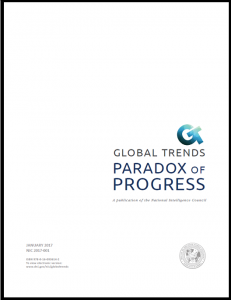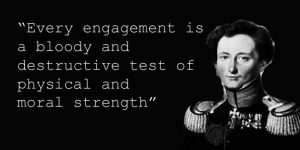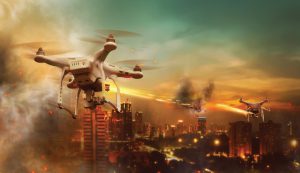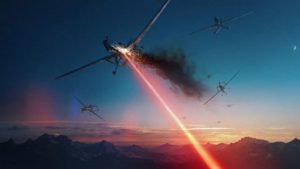[Editor’s Note: Mad Scientist Laboratory is pleased to present the following post by guest blogger LTC Rob Taber, U.S. Army Training and Doctrine Command (TRADOC) G-2 Futures Directorate, clarifying the often confused character and nature of warfare, and addressing their respective mutability.]
No one is arguing that warfare is not changing. Where people disagree, however, is whether the nature of warfare, the character of warfare, or both are changing.

Take, for example, the National Intelligence Council’s assertion in “Global Trends: Paradox of Progress.” They state, “The nature of conflict is changing. The risk of conflict will increase due to diverging interests among major powers, an expanding terror threat, continued instability in weak states, and the spread of lethal, disruptive technologies. Disrupting societies will become more common, with long-range precision weapons, cyber, and robotic systems to target infrastructure from afar, and more accessible technology to create weapons of mass destruction.”[I]
Additionally, Brad D. Williams, in an introduction to an interview he conducted with Amir Husain, asserts, “Generals and military theorists have sought to characterize the nature of war for millennia, and for long periods of time, warfare doesn’t dramatically change. But, occasionally, new methods for conducting war cause a fundamental reconsideration of its very nature and implications.”[II] Williams then cites “cavalry, the rifled musket and Blitzkrieg as three historical examples”[III] from Husain and General John R. Allen’s (ret.) article, “On Hyperwar.”
Unfortunately, the NIC and Mr. Williams miss the reality that the nature of war is not changing, and it is unlikely to ever change. While these authors may have simply interchanged “nature” when they meant “character,” it is important to be clear on the difference between the two and the implications for the military. To put it more succinctly, words have meaning.
The nature of something is the basic make up of that thing. It is, at core, what that “thing” is. The character of something is the combination of all the different parts and pieces that make up that thing. In the context of warfare, it is useful to ask every doctrine writer’s personal hero, Carl Von Clausewitz, what his views are on the matter.

He argues that war is “subjective,”[IV] “an act of policy,”[V] and “a pulsation of violence.”[VI] Put another way, the nature of war is chaotic, inherently political, and violent. Clausewitz then states that despite war’s “colorful resemblance to a game of chance, all the vicissitudes of its passion, courage, imagination, and enthusiasm it includes are merely its special characteristics.”[VII] In other words, all changes in warfare are those smaller pieces that evolve and interact to make up the character of war.
 The argument that artificial intelligence (AI) and other technologies will enable military commanders to have “a qualitatively unsurpassed level of situational awareness and understanding heretofore unavailable to strategic commander[s]”[VIII] is a grand claim, but one that has been made many times in the past, and remains unfulfilled. The chaos of war, its fog, friction, and chance will likely never be deciphered, regardless of what technology we throw at it. While it is certain that AI-enabled technologies will be able to gather, assess, and deliver heretofore unimaginable amounts of data, these technologies will remain vulnerable to age-old practices of denial, deception, and camouflage.
The argument that artificial intelligence (AI) and other technologies will enable military commanders to have “a qualitatively unsurpassed level of situational awareness and understanding heretofore unavailable to strategic commander[s]”[VIII] is a grand claim, but one that has been made many times in the past, and remains unfulfilled. The chaos of war, its fog, friction, and chance will likely never be deciphered, regardless of what technology we throw at it. While it is certain that AI-enabled technologies will be able to gather, assess, and deliver heretofore unimaginable amounts of data, these technologies will remain vulnerable to age-old practices of denial, deception, and camouflage.
 The enemy gets a vote, and in this case, the enemy also gets to play with their AI-enabled technologies that are doing their best to provide decision advantage over us. The information sphere in war will be more cluttered and more confusing than ever.
The enemy gets a vote, and in this case, the enemy also gets to play with their AI-enabled technologies that are doing their best to provide decision advantage over us. The information sphere in war will be more cluttered and more confusing than ever.
Regardless of the tools of warfare, be they robotic, autonomous, and/or AI-enabled, they remain tools. And while they will be the primary tools of the warfighter, the decision to enable the warfighter to employ those tools will, more often than not, come from political leaders bent on achieving a certain goal with military force.

Finally, the violence of warfare will not change. Certainly robotics and autonomy will enable machines that can think and operate without humans in the loop. Imagine the future in which the unmanned bomber gets blown out of the sky by the AI-enabled directed energy integrated air defense network. That’s still violence. There are still explosions and kinetic energy with the potential for collateral damage to humans, both combatants and civilians.

Not to mention the bomber carried a payload meant to destroy something in the first place. A military force, at its core, will always carry the mission to kill things and break stuff. What will be different is what tools they use to execute that mission.
To learn more about the changing character of warfare:
– Read the TRADOC G-2’s The Operational Environment and the Changing Character of Warfare paper.
– Watch The Changing Character of Future Warfare video.
Additionally, please note that the content from the Mad Scientist Learning in 2050 Conference at Georgetown University, 8-9 August 2018, is now posted and available for your review:
– Read the “Top Ten” Takeaways from the Learning in 2050 Conference.
– Watch videos of each of the conference presentations on the TRADOC G-2 Operational Environment (OE) Enterprise YouTube Channel here.
– Review the conference presentation slides (with links to the associated videos) on the Mad Scientist All Partners Access Network (APAN) site here.
LTC Rob Taber is currently the Deputy Director of the Futures Directorate within the TRADOC G-2. He is an Army Strategic Intelligence Officer and holds a Master of Science of Strategic Intelligence from the National Intelligence University. His operational assignments include 1st Infantry Division, United States European Command, and the Defense Intelligence Agency.
Note: The featured graphic at the top of this post captures U.S. cavalrymen on General John J. Pershing’s Punitive Expedition into Mexico in 1916. Less than two years later, the United States would find itself fully engaged in Europe in a mechanized First World War. (Source: Tom Laemlein / Armor Plate Press, courtesy of Neil Grant, The Lewis Gun, Osprey Publishing, 2014, page 19)
_______________________________________________________
[I] National Intelligence Council, “Global Trends: Paradox of Progress,” January 2017, https://www.dni.gov/files/documents/nic/GT-Full-Report.pdf, p. 6.
[II] Brad D. Williams, “Emerging ‘Hyperwar’ Signals ‘AI-Fueled, machine waged’ Future of Conflict,” Fifth Domain, August 7, 2017, https://www.fifthdomain.com/dod/2017/08/07/emerging-hyperwar-signals-ai-fueled-machine-waged-future-of-conflict/.
[III] Ibid.
[VI] Carl Von Clausewitz, On War, ed. Michael Howard and Peter Paret (Princeton: Princeton University Press, 1976), 85.
[V] Ibid, 87.
[VI] Ibid.
[VII] Ibid, 86.
[VIII] John Allen, Amir Hussain, “On Hyper-War,” Fortuna’s Corner, July 10, 2017, https://fortunascorner.com/2017/07/10/on-hyper-war-by-gen-ret-john-allenusmc-amir-hussain/.




The NIC report claims that the nature of “conflict” is changing. Your argument then conflates conflict and war. Was that your intention? Might there utility in examining conflict as a phenomenon separate or different from war? Could the nature of conflict change (despite being grounded in politics) while the nature of war does not?
As an Army officer, I admit to using “conflict” and “war” interchangeably. In place of “conflict,” I would fall back to the word “competition,” which the Army is using in its concept for future operations, “Multi-Domain Operations.” All that being said, there may certainly be merit in examining the nature of actions short of armed conflict/war to determine what impact advancing technologies would have on the character and nature of interactions of states, non-states, and individuals.
I think the term competition has the wrong connotation. It sounds a little too friendly and many of those on the field of play right now are anything but friendly. In my mind, in order for the term “war” to retain any meaning it has to involve violence; the uniqueness of it as an instrument of policy. That’s why I do like the term conflict as being distinct from war, or which war is a subset. It gives us room to examine hostile behavior short of violence. Absent violence, conflict’s nature is not as well understood (we have no Clausewitz to lean on). Perhaps the information age is changing the nature of conflict. Even Sec Def Mattis is asking the question.
Great points, thank you.
War, conflict, aggresive competition where people can get hurt or killed (whether locally or on a global scale) doesn’t change with the introduction of new ways to do what is essentially the same thing: win the competition.
If the intent is to define a word’s meaning, ok, yet didn’t Clausewitz define “war” as “…the continuation of politics by other means?” So diplomacy is to defuse politics gone bad (war) which essentially (from my tank turret) means the fighting hasn’t changed, what has changed is the “how” aspect.
An unmanned bomber is as much a “truck to bring stuff to the battlefield” as a manned bomber is. A laser shooting it down does the same thing as a SAM or AAA. Getting a projectile to the adversary faster is the goal so you win. Cyber is another way to help an opponent to gain something (land, resources, etc) because it helps take down the other side’s defenses so bullet launchers can get through (just like EW led the way for Desert Storm with TF Normandy and its jamming aircraft and Apaches knocking a hole in Iraqi IADS so F-117s and more traditional bomb droppers could get through the defenses to blow stuff up–with precision and not via carpet bombing.
Weapon (tool) use is the issue; after all, eventually you develop weapons so powerful that their “look what I’ve got” aspect can generate the hubris of survival “if we strike first, and hardest.”
Or, simply, have the “10th Man” option to step back and go: “the best option is not to play” that occurred in the 1983 movie “War Games” predating the layout of such an option that occurred in “World War Z” by 30 years.
https://www.youtube.com/watch?v=NHWjlCaIrQo